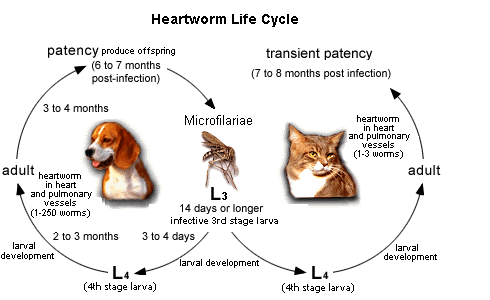
|
Knowing the heartworm life cycle and how Dirofilaria immitis reproduces is a key factor in understanding why this parasite is such a problem. According to Diana Beam, DVM, the life cycle begins when a dog that is infected with microfilaria in its blood is bitten by a mosquito. When the mosquito bites the infected dog, some of the microfilaria are sucked up into the mosquito. Inside the mosquito’s body, the microfilaria go through two molts in a period of about 14 days, depending on the temperature of the outside environment. These two molts change the larva from an L1 to an L2 stage, then from the L2 to the L3 stage. Once the larvae are in the L3 stage, they are ready to burrow and find a host organism. Once the mosquito bites its host, a dog in this case, it goes through its fourth molting stage, L3 to L4 within the first 14 days. The second molt from L4 to L5 occurs a couple months later. The larva is considered a juvenile working its way through the blood vessels to the heart. Juveniles arrive at the heart about 90 days after entering the host. After about three months after arriving at the heart, the worm achieves sexual maturity and continues to grow in size. On average, female worms are much larger than the male worms because they produce the eggs (Beam 2007).
According to Rick Gillis, when it comes to most nematodes, they are dioecious, male and female separate, and have internal fertilization. The male’s posterior has a pair of spicules that hold open the entrance to the female reproductive tract so the sperm can enter and fertilize the eggs (Gillis 2002). Once these eggs are hatched, they continue to grow inside the host organism, and wait to be transferred to a mosquito to start over a new life cycle. With the growing number of worms inside the right ventricle, there is a significant amount of blood that is blocked from going into the heart, decreasing perfusion and gas exchange in the host organism.
|
